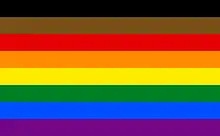LGBT symbols
The LGBT community has adopted certain symbols for self-identification to demonstrate unity, pride, shared values, and allegiance to one another. LGBT symbols communicate ideas, concepts, and identity both within their communities and to mainstream culture. The two most-recognized international LGBT symbols are the pink triangle and the rainbow flag.
| LGBT symbols |
|---|
| Flags |
| Other symbols |
| Part of a series on |
| LGBT topics |
|---|
| lesbian ∙ gay ∙ bisexual ∙ transgender |
|
|
Flags
Rainbow
Gilbert Baker designed the rainbow Pride flag for the 1978 San Francisco Gay Freedom Day celebration. He designed the flag as a "symbol of hope" and liberation, and an alternative to the symbolism of the pink triangle.[1] The flag does not depict an actual rainbow. Rather, the colors of the rainbow are displayed as horizontal stripes, with red at the top and violet at the bottom. It represents the diversity of gays and lesbians around the world. In the original eight-color version, pink stood for sexuality, red for life, orange for healing, yellow for the sun, green for nature, turquoise for art, indigo for harmony, and violet for spirit.[2] A copy of the original 20-by-30 foot, eight-color flag was remade by Baker in 2000, and was installed in the Castro district in San Francisco.[3] Many variations on the rainbow flag exist, including incorporating other LGBT symbols like the triangle or lambda.[4]
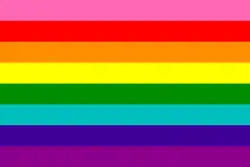 Original eight-stripe version designed by Gilbert Baker (1978)
Original eight-stripe version designed by Gilbert Baker (1978)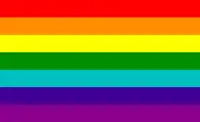 Seven-stripe version with hot pink color removed due to a lack of fabric (1978–1979)
Seven-stripe version with hot pink color removed due to a lack of fabric (1978–1979)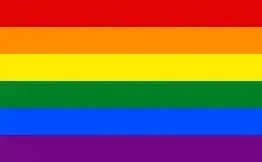 Six-stripes version with turquoise color removed and indigo color changed to royal blue (1979–present)
Six-stripes version with turquoise color removed and indigo color changed to royal blue (1979–present)
Aromanticism
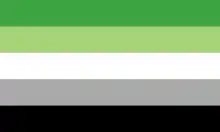
The aromantic pride flag consists of five horizontal stripes, which, from top to bottom, are: green, light green, white, gray, and black. In this order, the stripes represent aromanticism, the aromantic spectrum, aesthetic attraction, gray-aromantic and demiromantic people, and the sexuality spectrum.[5]
Asexuality

The asexual pride flag consists of four horizontal stripes: black, gray, white, and purple from top to bottom.[6][7] The flag was created by Asexual Visibility and Education Network user standup in August 2010, as part of a community effort to create and choose a flag.[8] The black stripe represents asexuality; the gray stripe represents gray-asexuals and demisexuals; the white stripe represents allies; and the purple stripe represents community.[9][10]
Bear culture

Bear is an affectionate gay slang term for those in the bear communities, a subculture in the gay community and an emerging subset of the LGBT community with its own events, codes, and a culture-specific identity. Bears tend to have hairy bodies and facial hair; some are heavy-set; some project an image of working-class masculinity in their grooming and appearance, though none of these are requirements or unique indicators. The bear concept can function as an identity, an affiliation, and an ideal to live up to. There is ongoing debate in bear communities about what constitutes a bear. Some state that self-identifying as a bear is the only requirement, while others argue that bears must have certain physical characteristics, such as a hairy chest and face, a large body, or a certain mode of dress and behavior.
Bears are almost always gay or bisexual men; transgender men attracted to other men are increasingly included within bear communities.[11] The bear community has spread all over the world, with bear clubs in many countries. Bear clubs often serve as social and sexual networks for older, hairier, sometimes heavier gay and bisexual men, and members often contribute to their local gay communities through fundraising and other functions. Bear events are common in heavily gay communities.
The International Bear Brotherhood Flag was designed in 1995 by Craig Byrnes.[12]
Bisexuality
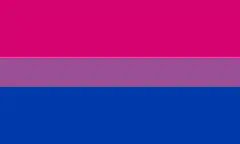
First unveiled on 5 December 1998,[13] the bisexual pride flag was designed by Michael Page to represent and increase visibility of bisexuals in the LGBT community and society as a whole. This rectangular flag consists of a broad magenta stripe at the top, a broad stripe in blue at the bottom, and a narrower deep lavender band occupying the central fifth.
Page describes the meaning of the pink, lavender, and blue (ratio 2:1:2) flag as this: "The pink color represents sexual attraction to the same sex only (gay and lesbian). The blue represents sexual attraction to the opposite sex only (straight) and the resultant overlap color purple represents sexual attraction to both sexes (bi)." He also describes the flag's meaning in deeper terms, stating "The key to understanding the symbolism of the Bisexual pride flag is to know that the purple pixels of color blend unnoticeably into both the pink and blue, just as in the 'real world,' where bi people blend unnoticeably into both the gay/lesbian and straight communities.[9]
The blue and pink overlapping triangle symbol represents bisexuality and bi pride. The origin of the symbol, sometimes facetiously referred to as the "biangles", is largely unknown, however the colors of bisexuality originate from this symbol: pink for attraction to women, blue for attraction to men, and lavender for attraction to both, as well as a reference to queerness.[9]
Intersex

Intersex people are those who do not exhibit all the biological characteristics of male or female, or exhibit a combination of characteristics, at birth. Between 0.05% and 1.7% of the population is estimated to have intersex traits.[14][15]
The intersex flag was created by Morgan Carpenter of Intersex Human Rights Australia in July 2013 to create a flag "that is not derivative, but is yet firmly grounded in meaning". The organization describes the circle as "unbroken and unornamented, symbolising wholeness and completeness, and our potentialities. We are still fighting for bodily autonomy and genital integrity, and this symbolises the right to be who and how we want to be".[16][17][18]
Lesbian
No single flag design for a lesbian pride flag has been widely adopted.[19] However, many widely used ones exist:
The labrys lesbian flag was created in 1999 by graphic designer Sean Campbell, and published in June 2000 in the Palm Springs edition of the Gay and Lesbian Times Pride issue.[10][19][20] The design involves a labrys, a type of double-headed axe, superimposed on the downward-pointing black triangle, set against a violet background. Among its functions, the labrys was associated as a weapon used by the Amazons of mythology.[21][22] In the 1970s it was adopted as a symbol of empowerment by the lesbian feminist community.[23][24] Women considered asocial by the Third Reich because they did not conform to the Nazi ideal of a woman, which included homosexual females, were condemned to concentration camps[25] and wore an downward-pointing black triangle badge to identify them.[26] Some lesbians reclaimed this symbol as gay men reclaimed the pink triangle (many lesbians also reclaimed the pink triangle although lesbians were not included in Paragraph 175 of the German criminal code).[26] The color violet became associated with lesbians via the poetry of Sappho.[27]
The "pink" lesbian flag consists of six shades of red and pink colors with a white bar in the center[28][29] and is derived from the lipstick lesbian flag, which includes a red kiss[29] (which was introduced in the weblog This Lesbian Life in 2010).[28] The lipstick lesbian flag represents "homosexual women who have a more feminine gender expression"[30] and has not been widely adopted;[19] however, its non-kiss "pink" variant attracted more use.
A new lesbian flag modeled after the seven-band "pink" flag was introduced on Tumblr in 2018, with colors dark orange representing 'gender non-conformity', orange for 'independence', light orange for 'community', white for 'unique relationships to womanhood', pink for 'serenity and peace', dusty pink for 'love and sex', and dark rose for 'femininity'.[31] A five-stripes version was soon derived from the 2018 colors.[32] In 2020, controversy arose over who had actually introduced an orange-pink lesbian flag.[33]
 Labrys lesbian flag created in 1999
Labrys lesbian flag created in 1999 Pink lesbian flag derived from the 2010 Lipstick lesbian flag
Pink lesbian flag derived from the 2010 Lipstick lesbian flag 2018 social media Lesbian flag
2018 social media Lesbian flag Five-stripes version of social media flag
Five-stripes version of social media flag
Non-binary
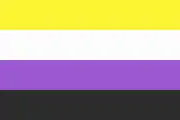
The non-binary flag was created in 2014 by activist Kye Rowan.[34] Each stripe color represents different types of non-binary identities: Yellow for people who identify outside of the gender binary, white for nonbinary people with multiple genders, purple for those with a mixture of both male and female genders, and black for agender individuals.[35]
Under the non-binary umbrella are all those who identify off the gender binary. There are many different identities within this category including androgyny, genderqueerness (which includes agender, ceterosexual,[36] gender fluid, intergender), third gender, and transgender.[37][38]
Pansexuality

The pansexual pride flag was introduced in October 2010 in a Tumblr blog ("Pansexual Pride Flag").[39] It has three horizontal bars that are pink, yellow and blue.[39][40][41] "The pink represents being attracted to women, the blue being attracted to men, and the yellow for being attracted to everyone else.";[39] such as non-binary gender, agender, bigender or genderfluid.[41][9][42][43]
A "P" with the tail converted to an arrow with a cross is also sometimes used. It predates the flag and is still in use today. The cross on the "P"'s tail refers to the cross on the Venus or female symbol (♀), and the arrow refers to the arrow on the Mars or male symbol (♂).[44] While it does not technically have a name, it is sometimes colloquially referred to as "the pansexual symbol".
Transgender
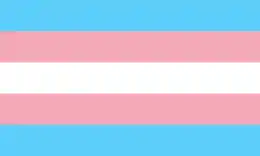
The Transgender Pride Flag was designed by transgender woman Monica Helms in 1999.[45] It was first shown at a pride parade in Phoenix, Arizona, US, in 2000.[46] It was flown from a large public flagpole in San Francisco's Castro District beginning November 19, 2012, in commemoration of the Transgender Day of Remembrance.[46] The flag represents the transgender community and consists of five horizontal stripes: two light blue, two pink, with a white stripe in the center. Helms described the meaning of the flag as follows:
- "The stripes at the top and bottom are light blue, the traditional color for baby boys. The stripes next to them are pink, the traditional color for baby girls.[46] The white stripe is for people that are nonbinary, feel that they don't have a gender."[47][48] The pattern is such that no matter which way you fly it, it is always correct, signifying us finding correctness in our lives.[46]
Philadelphia became the first county government in the U.S. to raise the transgender pride flag in 2015. It was raised at City Hall in honor of Philadelphia's 14th Annual Trans Health Conference, and remained next to the US and City of Philadelphia flags for the entirety of the conference. Then-Mayor Michael Nutter gave a speech in honor of the trans community's acceptance in Philadelphia.[49]
Other symbols
In addition to major symbols of the LGBT community, other symbols have been used to represent members' unity, pride, shared values, and allegiance to one another.
Ace ring

A black ring (also known as an ace ring) worn on the middle finger of one's right hand is a way asexual people signify their asexuality. The ring is deliberately worn in a similar manner as one would a wedding ring to symbolize marriage. Use of the symbol began in 2005.[50][51]
Ace cards
Due to the phonetic shortening from asexual to ace, ace playing cards are sometimes used to represent asexuality. The ace of hearts and ace of spades are used to symbolize romantic asexuality and aromantic asexuality respectively.[52] Likewise, the ace of clubs is used to symbolize gray asexuality and gray-aromantics, and the ace of diamonds is used to symbolize demi-romantics and demisexuals.[53]
Blue feather
In the Society for Creative Anachronism, LGBT members often wear a dark blue feather to indicate an affiliation with Clan Blue Feather, a group of SCA members promoting the study of LGBT culture and people in the Middle Ages.[54] Because of this affiliation, blue feathers have also been used at some Renaissance Faires and Pagan events.
Calamus plant

According to some interpretations, American poet Walt Whitman used the calamus plant to represent homoerotic love.[55]
Double-gender

Interlocked gender symbols. Each gender symbol derives from the astronomical symbol for the planet Venus and Mars. In modern science, the singular symbol for Venus is used to represent the female sex, and singular symbol for Mars is used to represent the male sex.[56] Two interlocking female symbols (⚢) represent a lesbian or the lesbian community, and two interlocking male symbols (⚣) a gay male or the gay male community.[57][58]
The symbols first appeared in the 1970s.[58]
Freedom rings
Freedom rings, designed by David Spada, are six aluminum rings, each in one of the colors of the rainbow flag. They were released in 1991.[59] Symbolizing happiness and diversity, these rings are worn by themselves or as part of necklaces, bracelets, and key chains.[59]
They are sometimes referred to as "Fruit Loops".[60]
Handkerchief code
In some New York City gay circles of the early 20th century, gay men wore a red necktie or bow tie as a subtle signal.[61] In the 1970s, the handkerchief (or hanky) code emerged in the form of bandanas, worn in back pockets, in colors that signaled sexual interests, fetishes, and if the wearer was a "top" or "bottom".[62][63]
High five
There are many origin stories of the high five,[64] but the two most documented candidates are Dusty Baker and Glenn Burke of the Los Angeles Dodgers professional baseball team on October 2, 1977, and Wiley Brown and Derek Smith of the Louisville Cardinals men's college basketball team during the 1978–1979 season.[65][66] In any case, after retiring from baseball, Burke, who was one of the first openly gay professional athletes, used the high five with other gay residents of the Castro district of San Francisco, where for many it became a symbol of gay pride and identification.[65]
Lambda

In 1970, graphic designer Tom Doerr selected the lower-case Greek letter lambda to be the symbol of the New York chapter of the Gay Activists Alliance.[67][68] The alliance's literature states that Doerr chose the symbol specifically for its denotative meaning in the context of chemistry and physics: "a complete exchange of energy–that moment or span of time witness to absolute activity".[67]
The lambda became associated with Gay Liberation,[69][70] and in December 1974, it was officially declared the international symbol for gay and lesbian rights by the International Gay Rights Congress in Edinburgh, Scotland.[71] The gay rights organization Lambda Legal and the American Lambda Literary Foundation derive their names from this symbol.
Lavender rhinoceros

Daniel Thaxton and Bernie Toale created a lavender rhinoceros symbol for a public ad campaign to increase visibility for gay people in Boston helmed by Gay Media Action-Advertising; Toale said they chose a rhinoceros because “it is a much maligned and misunderstood animal” and that it was lavender because that is a mix of pink and blue, making it a symbolic merger of the feminine and masculine. However, in May 1974, Metro Transit Advertising said its lawyers could not "determine eligibility of the public service rate" for the lavender rhinoceros ads, which tripled the cost of the ad campaign. Gay Media Action challenged this, but were unsuccessful. The lavender rhinoceros symbol was seen on signs, pins, and t-shirts at the Boston Pride Parade later in 1974, and a life-sized papier-mâché lavender rhinoceros was part of the parade. Money was raised for the ads, and they began running on the Massachusetts Bay Transportation Authority's Green Line by December 3, 1974, and ran there until February 1975. The lavender rhinoceros continued as a symbol of the gay community, appearing at the 1976 Boston Pride Parade and on a flag that was raised at Boston City Hall in 1987.[72]
Purple hand
On October 31, 1969, sixty members of the Gay Liberation Front, the Committee for Homosexual Freedom (CHF), and the Gay Guerilla Theatre group staged a protest outside the offices of the San Francisco Examiner in response to a series of news articles disparaging people in San Francisco's gay bars and clubs.[73][74][75][76] The peaceful protest against the Examiner turned tumultuous and was later called "Friday of the Purple Hand" and "Bloody Friday of the Purple Hand".[76][77][78][79][80][81] Examiner employees "dumped a barrel of printers' ink on the crowd from the roof of the newspaper building", according to glbtq.com.[82] Some reports state that it was a barrel of ink poured from the roof of the building.[83] The protestors "used the ink to scrawl slogans on the building walls" and slap purple hand prints "throughout downtown [San Francisco]" resulting in "one of the most visible demonstrations of gay power" according to the Bay Area Reporter.[76][78][81] According to Larry LittleJohn, then president of Society for Individual Rights, "At that point, the tactical squad arrived – not to get the employees who dumped the ink, but to arrest the demonstrators. Somebody could have been hurt if that ink had gotten into their eyes, but the police were knocking people to the ground."[76] The accounts of police brutality include women being thrown to the ground and protesters' teeth being knocked out.[76][84] Inspired by Black Hand extortion methods of Camorra gangsters and the Mafia,[85] some gay and lesbian activists attempted to institute "purple hand" as a warning to stop anti-gay attacks, but with little success. In Turkey, the LGBT rights organization MorEl Eskişehir LGBTT Oluşumu (Purple Hand Eskişehir LGBT Formation), also bears the name of this symbol.[86]
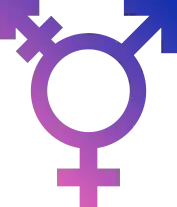
Transgender
A symbol of the female (♀), male (♂) and Genderqueer (⚨) symbols combined around a circle (⚧) is used to represent transgender people.[87][88]
Unicorns

Unicorns have become a symbol of LGBT culture due to earlier associations between the animal and rainbows being extended to the rainbow flag created in 1978 by Gilbert Baker.[89]
Language of flowers
Green carnation
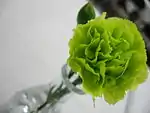
In 19th-century England, green indicated homosexual affiliations. Victorian gay men would often pin a green carnation on their lapel as popularized by openly gay author Oscar Wilde, who often wore one on his lapel.[90][91]
Violets

Violets and their color became a special code used by lesbians and bisexual women.[92][93][94] The symbolism of the flower derives from several fragments of poems by Sappho in which she describes a lover wearing garlands or a crown with violets.[95][96] In 1926, the play La Prisonnière by Édouard Bourdet used a bouquet of violets to signify lesbian love.[97] When the play became subject to censorship, many Parisian lesbians wore violets to demonstrate solidarity with its lesbian subject matter.[98]
Triangle badges of the Third Reich
One of the oldest of these symbols is the downward-pointing pink triangle that male homosexuals in Nazi concentration camps were required to wear on their clothing. The badge is one of several badges that internees wore to identify what kind of prisoners they were.[99] Many of the estimated 5,000–15,000 gay men and lesbians imprisoned in concentration camps died during the Holocaust.[100] The pink triangle was later reclaimed by gay men, as well as some lesbians, in various political movements as a symbol of personal pride and remembrance.[101][26] AIDS Coalition to Unleash Power (ACT-UP) adopted the downward-pointing pink triangle to symbolize the "active fight back" against HIV/AIDS "rather than a passive resignation to fate."[102]
The pink triangle was used exclusively with male prisoners, as lesbians were not included under Paragraph 175, a statute which made homosexual acts between males a crime. The United States Holocaust Memorial Museum (USHMM) stipulates that this was because women were seen as subordinate to men, and the Nazi state did not feel that homosexual women presented the same threat to masculinity as homosexual men. According to USHMM, many women were arrested and imprisoned for "asocial" behavior, a classification applied to those who did not conform to the Nazi ideal of a woman's role: cooking, cleaning, kitchen work, child raising, and passivity. Asocial women were tagged with an downward-pointing black triangle.[25] Many lesbians reclaimed this symbol for themselves as gay men reclaimed the pink triangle.[26]
| Pink Triangle | Black Triangle | Pink & Yellow Triangles |
|---|---|---|
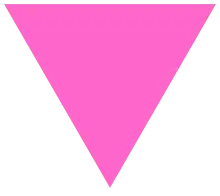 |
 |
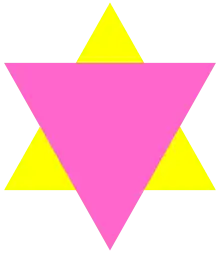 |
| The downward-pointing pink triangle used to identify homosexual men in the concentration camps. | The downward-pointing black triangle used to mark individuals considered "asocial". The category included homosexual women, nonconformists, sex workers, nomads, Romani, and others. | The downward-pointing pink triangle overlapping a yellow triangle was used to single out male homosexual prisoners who were Jewish. |
Gallery
LGBT pride flags
These LGBT flags represent the LGBT movement as a whole with sexual orientations, gender identities, subcultures, and regional purposes.

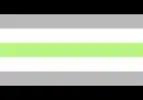



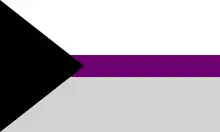 Demisexual[105]
Demisexual[105]
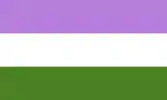

 Lesbian (labrys design)
Lesbian (labrys design) Lesbian Pride
Lesbian Pride
(based on Lipstick lesbian flag) 2018 Lesbian flag introduced in social media
2018 Lesbian flag introduced in social media Five-stripes variant of 2018 Lesbian flag
Five-stripes variant of 2018 Lesbian flag

 Polysexual[106]
Polysexual[106]
Subculture flags


 Illustration of Lipstick lesbian flag[29]
Illustration of Lipstick lesbian flag[29]
Location-based flags
Symbols
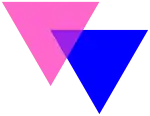 Biangles
Biangles
(represents Bisexuality) Double moon
Double moon
(represents Bisexuality) Double female symbol
Double female symbol
(represents Lesbian women) Double male symbol
Double male symbol
(represents Gay men) Labrys
Labrys
(represents Lesbian feminism) Lambda
Lambda
(represents Gay Liberation)


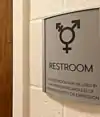 Transgender symbol denoting gender-neutral restroom
Transgender symbol denoting gender-neutral restroom
See also
References
- "Rainbow Flag: Origin Story". Gilbert Baker Foundation. 2018. Archived from the original on June 18, 2018.
- "Carleton College: Gender and Sexuality Center: Symbols of Pride of the LGBTQ Community". Apps.carleton.edu. 2005-04-26. Archived from the original on 2012-02-10. Retrieved 2012-01-23.
- Rochman, Sue (June 20, 2000). "Rainbow flap". The Advocate. p. 16. Retrieved 21 August 2018.
- Riffenburg, Charles Edward IV (2004). "Symbols of the Gay, Lesbian, Bisexual, and Transgender Movements". Queer Resources Directory. Retrieved July 25, 2019.
- Gillespie, Claire. "22 Different Pride Flags and What They Represent in the LGBTQ+ Community". Health.com. Retrieved 19 July 2020.
- Bilić, Bojan; Kajinić, Sanja (2016). Intersectionality and LGBT Activist Politics: Multiple Others in Croatia and Serbia. Springer. pp. 95–96.
- Decker, Julie. The Invisible Orientation: An Introduction to Asexuality. Skyhorse.
- "The Asexuality Flag". Asexuality Archive. 20 February 2012.
- Petronzio, Matt (June 13, 2014). "A Storied Glossary of Iconic LGBT Flags and Symbols". Mashable. Retrieved 17 July 2014.
- Sobel, Ariel (June 13, 2018). "The Complete Guide to Queer Pride Flags". The Advocate. Retrieved 28 June 2018.
- Barucco, Renato. "Transgender People: Strangers in Gay Land". Huffpost. Retrieved 28 December 2020.
- "Flag History". Bearmfg.com. Archived from the original on 2012-02-11. Retrieved 2012-01-23.
- "History, Bi Activism, Free Graphics". BiFlag.com. 1998-12-05. Archived from the original on 2012-02-04. Retrieved 2012-01-23.
- https://www.unfe.org/wp-content/uploads/2017/05/UNFE-Intersex.pdf
- "How common is intersex? | Intersex Society of North America". Isna.org. Retrieved 2009-08-21.
- An intersex flag, Intersex Human Rights Australia, 5 July 2013
- Are you male, female or intersex? Archived 2016-09-23 at the Wayback Machine, Amnesty International Australia, 11 July 2013
- Intersex advocates address findings of Senate Committee into involuntary sterilisation Archived 2016-01-15 at the Wayback Machine, Gay News Network, 28 October 2013
- Bendix, Trish (September 8, 2015). "Why don't lesbians have a pride flag of our own?". AfterEllen. Archived from the original on September 9, 2015. Retrieved 8 June 2019.
- Kasandra Brabaw (19 June 2019). "A Complete Guide To All The LGBTQ+ Flags & What They Mean". Refinery29. Retrieved 6 July 2019.
- "Gay Symbols Through the Ages". The Alyson Almanac: A Treasury of Information for the Gay and Lesbian Community. Boston, Massachusetts: Alyson Publications. 1989. pp. 99–100. ISBN 0-932870-19-8.
- Murphy, Timothy F., ed. (2000). Reader's Guide to Lesbian and Gay Studies (1st ed.). Chicago, Illinois: Fitzroy Dearborn Publishers. p. 44. ISBN 1-57958-142-0.
- Zimmerman, Bonnie, ed. (2000). "Symbols, Christy Stevens". Lesbian Histories and Cultures: An Encyclopedia (1st ed.). New York, New York: Garland Publishing. p. 748. ISBN 0-8153-1920-7.
- Pea, Georgie (9 August 2013). "LABRYS Tool of Lesbian Feminism". Finding Lesbians. Retrieved 4 August 2018.
- "Lesbians and the Third Reich". United States Holocaust Memorial Museum. Retrieved 16 January 2015.
- Elman, R. Amy. "Triangles and Tribulations: The Politics of Nazi Symbols". Remember.org. Retrieved December 10, 2016. (Originally published in the Journal of Homosexuality, 1996, 30 (3): pp.1–11, doi:10.1300/J082v30n03_01, ISSN 0091-8369)
- Prager, Sarah (January 29, 2020). "Four Flowering Plants That Have Been Decidedly Queered (Sapphic Violets)". JSTOR Daily. Retrieved 19 July 2020.
- Mathers, Charlie (1 January 2018). "18 Pride flags you might not have seen before". Gay Star News. Retrieved 4 June 2019.
- Rawles, Timothy (July 12, 2019). "The many flags of the LGBT community". San Diego Gay & Lesbian News. Retrieved 3 September 2019.
- Blaxk, Natasha A.; Stern, Alana (June 22, 2016). "9 Queer Pride Flags That You Probably Didn't Know About". Odyssey. Retrieved 23 January 2019.
- "Lesbian Flag, Sadlesbeandisaster". Majestic Mess. April 2019. Retrieved 1 December 2019.
- Paul Murphy-Kasp (6 July 2019). "Pride in London: What do all the flags mean?". BBC. Retrieved 6 July 2019.
- Chris 🌟🔥 #bIm [@Catastrfy] (June 26, 2020). "does this work for you? i know from my notes that i used the butch/femme bright saturated pinks to make the violet lesbian flag, and i have a violet file dated 6 mar 16. but what i can actually FIND is this 1000x1000 px button file for the butch/femme flag dated 8 mar 2016" (Tweet). Retrieved July 2, 2020 – via Twitter.
- Glass, Jess (26 June 2018). "Pride flags: All of the flags you might see at Pride and what they mean". PinkNews. Retrieved 19 April 2019.
- Anonymous. "Everything you never understood about being nonbinary". Gaygull. Gaygull. Retrieved 19 April 2019.
- "Genderqueer and Non-Binary Identities & Terminology". Genderqueer and Non-Binary Identities. July 24, 2015. Retrieved 10 June 2020.
- "Gender Alphabet" (PDF). Safe Homes. Open Sky Community Services. 2010. Retrieved 17 May 2019.
- Kandola, Aaron (18 April 2018). "What does nonbinary mean?". Medical News Today. Healthline Media UK. Retrieved 17 May 2019.
- "A field guide to Pride flags". Clare Bayley. 27 June 2013. Archived from the original on 24 July 2014. Retrieved 17 July 2014.
- "Pansexual Pride Day Today". Shenandoah University. December 5, 2016. Archived from the original on August 20, 2017. Retrieved 17 July 2014.
- "Do You Have a Flag?". Freedom Requires Wings. 9 November 2012. Retrieved 17 July 2014.
- "Cantú Queer Center - Sexuality Resources". Archived from the original on 17 May 2017. Retrieved 17 July 2014.
- "Gay & Lesbian Pride Symbols - Common Pride Symbols and Their Meanings". Archived from the original on 2016-09-28. Retrieved 17 July 2014.
- Agnes. "Sexual Orientation Files: Pansexual". Avia-Viridis. Neocities. Archived from the original on June 27, 2018. Retrieved 27 June 2018.
- Fairyington, Stephanie (12 November 2014). "The Smithsonian's Queer Collection". The Advocate. Retrieved 5 June 2015.
- "Transgender Flag Flies In San Francisco's Castro District After Outrage From Activists" by Aaron Sankin, HuffingtonPost, November 20, 2012
- Gray, Emma; Vagianos, Alanna (July 27, 2017). "We Have A Navy Veteran To Thank For The Transgender Pride Flag". Huffington Post. Retrieved 2017-08-31.
- LB, Branson (July 26, 2017). "The Veteran Who Created The Trans Pride Flag Reacts To Trump's Trans Military Ban". Buzzfeed. Retrieved 2018-08-31.
- "Philadelphia Raises the Transgender Pride Flag for the First Time". The Advocate. 4 June 2015.
- Chasin, CJ DeLuzio (2013). "Reconsidering Asexuality and Its Radical Potential" (PDF). Feminist Studies. 39 (2): 405–426. ISSN 0046-3663.
- Besanvalle, James (31 July 2018). "Here's a handy way to tell if someone you meet is asexual". Gay Star News. Retrieved 18 February 2019.
- Julie Sondra Decker (2015). The Invisible Orientation: An Introduction to Asexuality. Simon and Schuster. ISBN 9781510700642. Retrieved 21 January 2020.
- "Introduction to Asexual Identities & Resource Guide". campuspride.org. July 28, 2014. Retrieved 2020-10-03.
- "Clan Blue Feather". Bluefeather.org. Retrieved 2018-06-28.
- Herrero-Brasas, Juan A. (2010). Walt Whitman's Mystical Ethics of Comradeship: Homosexuality and the Marginality of Friendship at the Crossroads of Modernity. SUNY. p. 46. ISBN 978-1-4384-3011-9.
- Melissa (May 8, 2015). "The Origin of the Male and Female Symbols". Today I Found Out. Retrieved 22 August 2018.
- Zimmerman, Bonnie, ed. (2000). "Symbols (by Christy Stevens)". Encyclopedia of Lesbian and Gay Histories and Cultures. 1 (Lesbian Histories and Cultures: An Encyclopedia) (1st ed.). Garland Publishing. p. 748. ISBN 0-8153-1920-7.
- "Symbols of the Gay, Lesbian, Bisexual, and Transgender Movements". lambda.org. LAMBDA GLBT Community Services. December 26, 2004. Archived from the original on December 30, 2005. Retrieved 22 August 2018.
- Van Gelder, Lindsy (1992-06-21). "Thing; Freedom Rings". New York Times. Retrieved 2010-07-21.
- Green, Jonathon (2006). Cassell's Dictionary of Slang. Sterling Publishing Company, Inc. ISBN 0-304-36636-6. Retrieved 2007-11-15.
- Chauncey, George (1994). Gay New York: Gender, Urban Culture, and the Making of the Gay Male World, 1890-1940. New York, New York: Basic Books. p. 52. ISBN 978-0-465-02633-3.
- "Do You Know the Hanky Code?". Gay Desert Guide. May 22, 2018. Retrieved 30 April 2020.
- Kacala, Alexander (April 25, 2019). "The Handkerchief Code, According to 'Bob Damron's Address Book' in 1980". The Saint Foundation. Retrieved 30 April 2020.
- Bob Brigham (1995). "The Man Who Invented the High-Five". The Diamond Angle. Outsports.com (2003). Retrieved July 25, 2014.
- Jon Mooallem. "The history and mystery of the high five", ESPN, 29 July 2011
- "The Gay History of the High Five". 2012-04-19. Retrieved 2017-03-06.
- Rapp, Linda (2004). "Gay Activists Alliance" (PDF). glbtq.com.
- "1969, The Year of Gay Liberation". The New York Public Library. June 2009. Retrieved 17 November 2018.
- Goodwin, Joseph P. (1989). "It Takes One to Know One". More Man Than You'll Ever Be: Gay Folklore and Acculturation in Middle America. Indiana University Press. p. 26. ISBN 978-0253338938.
- Rapp, Linda (2003). "Symbols" (PDF). glbtq.com.
- Haggerty, George E., ed. (2000). Gay Histories and Cultures: An Encyclopedia (Encyclopedia of Gay Histories and Cultures, Volume II) (1 ed.). London: Garland Publishing. p. 529. ISBN 0-8153-1880-4.
OCLC Number: 750790369
- /00:00Playing Live (2019-06-03). "How A Lavender Rhino Became A Symbol Of Gay Resistance In '70s Boston | The ARTery". Wbur.org. Retrieved 2019-12-05.
- Teal, Donn (1971). The Gay Militants: How Gay Liberation Began in America, 1969-1971. New York: St. Martin's Press. pp. 52–58. ISBN 0312112793.
- Gould, Robert E. (24 February 1974). "What We Don't Know About Homosexuality". New York Times Magazine. ISBN 9780231084376. Retrieved January 1, 2008.
- Laurence, Leo E. (October 31 – November 6, 1969). "Gays Penetrate Examiner". Berkeley Tribe. 1 (17). p. 4. Retrieved 7 August 2019.
- Alwood, Edward (1996). Straight News: Gays, Lesbians, and the News Media. Columbia University Press. p. 94. ISBN 0-231-08436-6. Retrieved January 1, 2008.
- Bell, Arthur (28 March 1974). "Has The Gay Movement Gone Establishment?". The Village Voice. ISBN 9780231084376. Retrieved January 1, 2008.
- Van Buskirk, Jim (2004). "Gay Media Comes of Age". Bay Area Reporter. Archived from the original on July 5, 2015. Retrieved 2008-01-01.
- Stryker, Susan; Buskirk, Jim Van (November 15–30, 1969). "Friday of the Purple Hand". San Francisco Free Press. ISBN 9780811811873. Retrieved January 1, 2008. (courtesy: the Gay Lesbian Historical Society.
- Martin, Del (December 1969). "The Police Beat: Crime in the Streets" (PDF). Vector (San Francisco). 5 (12): 9. Retrieved 1 June 2019.
- ""Gay Power" Politics". GLBTQ, Inc. 30 March 2006. Retrieved January 1, 2008.
- "glbtq >> social sciences >> San Francisco". Archived from the original on 2015-07-05. Retrieved 2019-12-11.
- Montanarelli, Lisa; Harrison, =Ann (2005). Strange But True San Francisco: Tales of the City by the Bay. Globe Pequot. ISBN 0-7627-3681-X. Retrieved January 1, 2008.
- Alwood, Edward (24 April 1974). "Newspaper Series Surprises Activists". The Advocate. ISBN 9780231084376. Retrieved January 1, 2008.
- Nash, Jay Robert (1993). World Encyclopedia of Organized Crime. Da Capo Press. ISBN 0-306-80535-9.
- "MorEl Eskişehir LGBTT Oluşumu". Moreleskisehir.blogspot.com. Retrieved January 23, 2012.
- "Transgender Symbol". Gender talk.
- "history of transgender symbolism". transgender society.
- Fisher, Alice (2017-10-15). "Why the unicorn has become the emblem for our times | Alice Fisher". the Guardian. Retrieved 2018-08-19.
- Stetz, Margaret D. (Winter 2000). Oscar Wilde at the Movies: British Sexual Politics and The Green Carnation (1960); Biography – Volume 23, Number 1, Winter 2000, pp. 90–107. Retrieved 14 June 2010.
- Curiosities of Literature by John Sutherland (2011, ISBN 1-61608-074-4), pp. 73-76.
- "Gay Symbols Through the Ages". The Alyson Almanac: A Treasury of Information for the Gay and Lesbian Community. Boston, Massachusetts: Alyson Publications. 1989. p. 100. ISBN 0-932870-19-8.
- Myers, JoAnne (2003). The A to Z of the Lesbian Liberation Movement: Still the Rage (The A to Z Guide Series, No. 73 ) (1st ed.). Lanham, Maryland: The Scarecrow Press. p. 242. ISBN 978-0-8108-6811-3.
- Horak, Laura (2016). "Lesbians Take Center Stage: The Captive (1926-1928)". Girls Will Be Boys: Cross-Dressed Women, Lesbians, and American Cinema, 1908-1934. Rutgers University Press. pp. 143–144. ISBN 978-0-8135-7483-7.
- Collecott, Diana (1999). H.D. and Sapphic Modernism 1910-1950 (1st ed.). Cambridge, England, UK: Cambridge University Press. p. 216. ISBN 0-521-55078-5.
- Fantham, Elaine; Foley, Helene Peet; Kampen, Natalie Boymel; Pomeroy, Sarah B.; Shapiro, H. A. (1994). Women in the Classical World: Image and Text (1st ed.). New York, New York: Oxford University Press. p. 15. ISBN 978-0-19-506727-9.
- Cohen-Stratyner, Barbara (January 14, 2014). "Violets and Vandamm". New York Public Library. Retrieved 4 October 2018.
- Sova, Dawn B. (2004). "The Captive". Banned Plays: Censorship Histories of 125 Stage Dramas (1st ed.). New York, New York: Facts On File. pp. 37–40. ISBN 0-8160-4018-4.
- Plant, Richard (1988). The pink triangle: the Nazi war against homosexuals (revised ed.). H. Holt. p. 175. ISBN 978-0-8050-0600-1.
- "Nazi Persecution of Homosexuals 1933-1945". Ushmm.org. Archived from the original on 2012-01-19. Retrieved 2012-01-23.
- Stier, Oren Baruch (2015). Holocaust Icons: Symbolizing the Shoah in History and Memory. Rutgers University Press. ISBN 9780813574059.
- Cage, Ken; Evans, Moyra (2003-01-01). Gayle: The Language of Kinks and Queens : a History and Dictionary of Gay Language in South Africa. Jacana Media. ISBN 9781919931494.
- Alatalo, Rachel (August 7, 2017). "Flags of the LGBTIQ Community". OutRight Action International.
- "Aromantic Flag". Majestic Mess. November 2018.
- "What is Demisexuality?". Demisexuality Resource Center. 2015. Archived from the original on 23 November 2016. Retrieved 2 October 2019.
- "Pride Flags". TriPrideTN. August 24, 2018.
- Owens, Ernest (June 8, 2017). "Philly's Pride Flag to Get Two New Stripes: Black and Brown". Philadelphia. Retrieved 26 May 2019.
- Grange, Helen (31 January 2011). "Coming out is risky business". Independent Online. Retrieved 4 July 2019.
External links
| Wikimedia Commons has media related to LGBT symbols. |
- LGBTQIA+ Flags and Symbols shows images of some of these symbols and offers a brief historical account of each.
